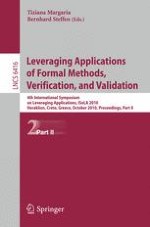2010 | Buch
Leveraging Applications of Formal Methods, Verification, and Validation
4th International Symposium on Leveraging Applications, ISoLA 2010, Heraklion, Crete, Greece, October 18-21, 2010, Proceedings, Part II
herausgegeben von: Tiziana Margaria, Bernhard Steffen
Verlag: Springer Berlin Heidelberg
Buchreihe : Lecture Notes in Computer Science
